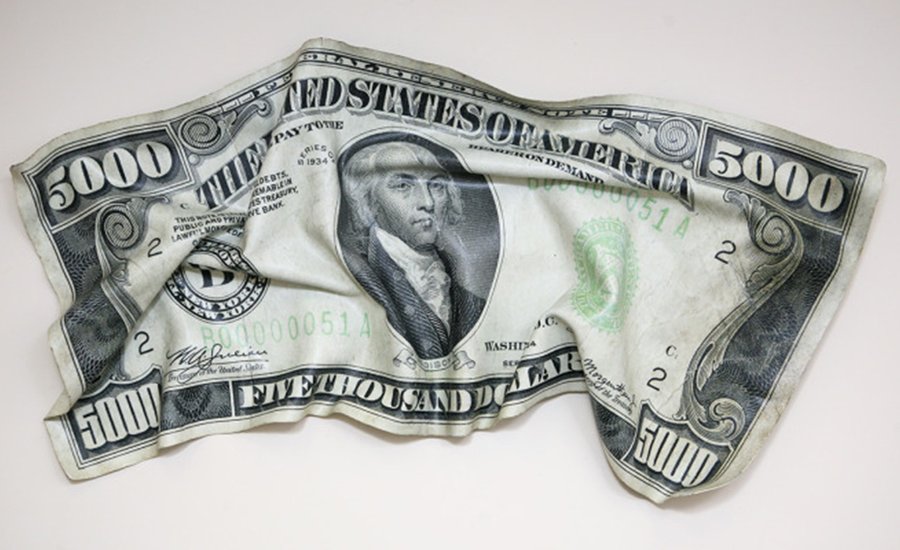The pricing of artworks is not a simple matter. And while the basic economic principles of supply and demand do still apply to the art market, the factors that contribute to an artist’s “supply,” or the availability of their art for sale, and an artist’s “demand,” or how many collectors are willing to buy their work and at what price, are quite complicated.
Artspace regularly publishes “Steal vs. Splurge” articles that compare exorbitant auction prices with artworks produced by artists that Artspace offers much more affordable alternatives for. In our latest edition, we found a 1990 lithograph by David Hockney that sold for $43,606 at auction, and a similar 1991 lithograph by David Hockney for $8,000, available on Artspace. How is that two prints by the same artist, from the same time period, differ by $35,000?
Here we breakdown the factors that contribute to an artist’s supply and demand, and thus the price of their artworks.
Primary Market vs. Secondary Market
Before we dig into how an artwork is priced, it's important to consider where it’s sold. Artworks are dealt on what are called the primary and secondary markets. The primary market refers to initial sales. An artist will make a work, consign it to a gallery, the gallery will sell it to a collector, and the gallery and artist will split the profit. And in some cases, the artist will sell to a collector directly from their studio, bypassing the gallery, at a lower price. These types of sales make up the primary market.
The secondary market, however, deals artworks that have already been sold on the primary market. If a collector has a work in their collection they’d like to offload, they’ll sell it on the secondary market, which is usually done via auction houses like Sotheby’s, Christie’s, or Phillips, or through the gallery where they initially purchased the work. In these cases, the artist receives no share in the profits.
Prices on the secondary market tend to be much higher than those on the primary market, mainly due to the fact that most artworks don’t accrue value over time significantly enough to justify a resale. Only works by historically significant, dead, or highly-demanded artists will sell on the secondary market. But within the secondary market, collectors can generally expect to find better deals at auction than from buying directly through galleries.
Demand: Exhibition History, Institutional Support, Market Trends, and Commercial Viability
It should go without saying that the more people that want an artwork, the more the dealer can sell it for. “If there are two people that want the same object, then each person increases the threshold,” collector and dealer Stefan Simchowitz tells Artspace. This is pretty basic economics here—so maybe the more interesting question to ask is, What makes some artworks highly demanded and others not?
We asked Jonas Lund, an artist known for making work about the art market, this very question. “The more people that want it, the more people believe it’s a good investment, the more people think that the artist is going to become huge, the bigger the competition and the higher the price,” says Lund. In this game of speculation, several factors contribute to whether or not an artist is likely to “become huge”—perhaps the most important one being the artist’s exhibition history.
A mid-career artist who is represented by a reputable gallery, has received a solo exhibition at a museum, and who has participated in institutional group shows or biennials, has better chances of “becoming huge” (and to demand high prices) than a recent MFA graduate who may just have one or two local group exhibitions at project spaces under their belt. Dealers and collectors look at an artist’s CV for information that could help predict the trajectory of their career; CVs include education, solo exhibitions, group exhibitions, artist residencies, awards, prizes, grants, fellowships, and inclusion in public/institutional collections.
Gallerists will often invite museum curators to see their shows in hopes of helping their artists become integrated into an institution’s program, thus ensuring the longevity and value of their career in the long term. "The art market really functions in a way where value is determined over long periods of time," says Simchowitz. "Whatever sort of valuation made based on a short time period can be quite volatile." Artists acquired by museums are considered "less volatile" since the longevity of their career is somewhat stabilized and validated by the institution. Not only do museum exhibitions help mid-career artists establish themselves, they also help raise the prices of secondary market sales, regardless of whether or not the artist is living. If an artist has a major retrospective or museum show, collectors will probably be willing to pay more at auction.
Now it’s important here to note the difference between price and value: an emerging artist may make art that is valuable in that it adds significantly to the trajectory of contemporary art—but it may not be monetarily valuable simply because the artist has not had the opportunity to show the work in spaces deemed worthy of the market’s attention. In an interview Artspace did with Chrissie Iles last month, the Whitney curator said, “I’m not against the market at all, but it’s important to remember that something is not necessarily historically significant just because it’s successful in the market.” So, you’re probably asking, how does an artist get to show in commercial galleries (and thus have access to collectors and have the opportunity to sell their work)? Why would galleries want to show them if they don’t make work that is “historically significant?”
Galleries come in all shapes and sizes, and while some of them are committed to showing artists who they believe are historically significant and will go down in art history as significant, others are more motivated to show art that is "commercially viable." Successful commercial dealers are able to spot young, emerging artists who are making artworks (usually paintings or two-dimensional works) that are congruent enough with current aesthetic trends to resonate with collectors in the know, but are unique enough to appeal to collectors looking for something that no one else has. A few years ago, neutral-colored abstract painting was hot; this year, colorful figurative painting is more in demand.
Supply: Editions and Multiples vs. Originals, and an Artist’s Rate of Production
So, we’ve gone over how the demand for an artist’s work can be influenced by where they’ve shown, whether or not they’ve been included in institutional programing, and the commercial viability of their work. But how does supply effect price? To answer this question, it’s important to understand the role of the edition and multiple.
A "unique work" refers to an artwork there is only one of—a painting or a sculpture, for instance. An edition or multiple refers to an artwork like a print, photograph, or video, which has multiple copies of the same thing. This isn’t to say, though, that editioned prints or multiples are reproductions. “For one thing, let us say that although prints are multiples, they are, in fact, originals,” says Chris Santa Maria ofGemini G.E.L. at Joni Moisant Weyl. “It is something we try to make sure collectors understand, as prints are often thought of as reproductions of unique works, and they’re not.”
That being said, the prices of prints and multiples are often less than an artist’s unique works—not because they are less “valuable” culturally, but instead, because there are simply more of them to go around. “The motivation for artists to make fine art editions is as varied as the artist themselves, but generally making their work more affordable to a larger audience is part of their attraction to the possibilities of editions,” says Santa Maria. For collectors wanting to own a work by a particular artist, buying an editioned artwork can be much more accessible. “There naturally becomes a point where the price of an editioned print cannot approach the price of a unique work.”
But artists also have control over how much work they allow to leave the studio, in effect, regulating their supply. Highly prolific artists, like Damien Hirst and Pablo Picasso, says Simchowitz, will make 5,000 to 10,000 artworks over their lifetime. A painter like JulieMehretu might only make a few paintings per year. So how much an artist produces and/or allows out of the studio can also have an effect on price.
Setting the Price: How Emerging Artists Enter the Market
Though there aren’t any hard-and-fast rules we can apply to art market pricing in general, it’s not too difficult to understand how prices reflect their maker’s career trajectory, or their position in the supply/demand matrix. But an even grayer area of this equation is in the emerging market, where artists who are just getting their first few solo shows need to figure out how to price their work before there is a demand for it.
“When a gallery is introducing the work of an artist at an early career stage, one has to platform the work to a wide audience. This means setting prices at a lower price point,” says Agusto Abrizo of Van Doren Waxter, formerly 11R and Eleven Rivington. Candice Madey of On Stellar Rays agrees: “I tend to err on the lower, more conservative side in order to start to sell. It’s very important that an artist young in their career is able to get their work out of the studio and into shows, homes, collections, and to build a following. Making the prices more attractive is helpful early on,” says Madey.
So how low is “low” and how do dealers and artists know where to start? Determing the price of an artwork by an emeriging artist involves considering “a combonation of where they are in their careers, the nature and complexity of their work, and knowing the clientele well,” explains Madey. If the artist has worked with the gallery before, gallerists will “factor in what progress has been made since their last show, such as whether it was sold to museums, or whether the artist has had institutional visibility (solo shows, inclusion in visible group shows), and if we have built up a following of people waiting to see new works. Usually this is the case, and I can justify raising pries without disrupting their development,” says Madey.
But although this may seem like a bit of a crapshoot, the repercussions of over-valuing art can be severe. "I tend to err on the conservative side to protect the artists from downturns in the market," Madey tells Artspace. "It's always easy to jack the prices up in boom times, but never easy to lower them. It's very bad for the artists, and your clients, to over inflate prices.”
Other Factors: Size, Production Cost, Materials
So far we’ve talked a whole lot about the artist’s career, and not much about the actual work. Obviously dealers and appraisers need to take a hard look at what the thing their trying to sell actually is.
Larger artworks will sell for more than smaller, similar artworks by the same artist. And if the artwork was very expensive to produce, or required an inordinate amount of labor, these factors may also be reflected in the price. But production costs don’t necessarily have as big an influence over an artwork's price as one might think. Speaking specifically of prints and editions, Santa Maria of Gemini G.E.L. says, “When establishing the initial price, we take everything into consideration except, ironically, the cost to make it!” Though some artists and dealers will make this consideration, it’s not nearly as important as the artist’s previous sale and exhibition history.
So, there you have it. The moral of the story might be that there is no hard-lined rules when it comes to pricing art, but rather, a complex web of factors that require a whole lot of speculation, comparison, and informed guesswork.



























